from Twitter

(Thread on study group, full reportback coming soon) The first RAM study group was very well attended. We plan to do monthly reading groups with a variety of different texts. We discussed the Combahee River Collective statement. Many different topics came up in the conversation including the importance of showing up in organizing spaces with intentionality to center the most oppressed, the need for the abolition of gender and the necessity to build a revolutionary movement in the United States to disrupt imperialism abroad. We also found that the CRC’s collective non-hierarchical practice and emphasis on criticism and self criticism should be something we aspire to in our own collective work. We are excited about our next study session next month. We hope to encourage a culture of learning with an emphasis on strategy towards building a liberated world.
RAM Study Group Brief Reportback
Philly Noise Demo Reportback
Submission
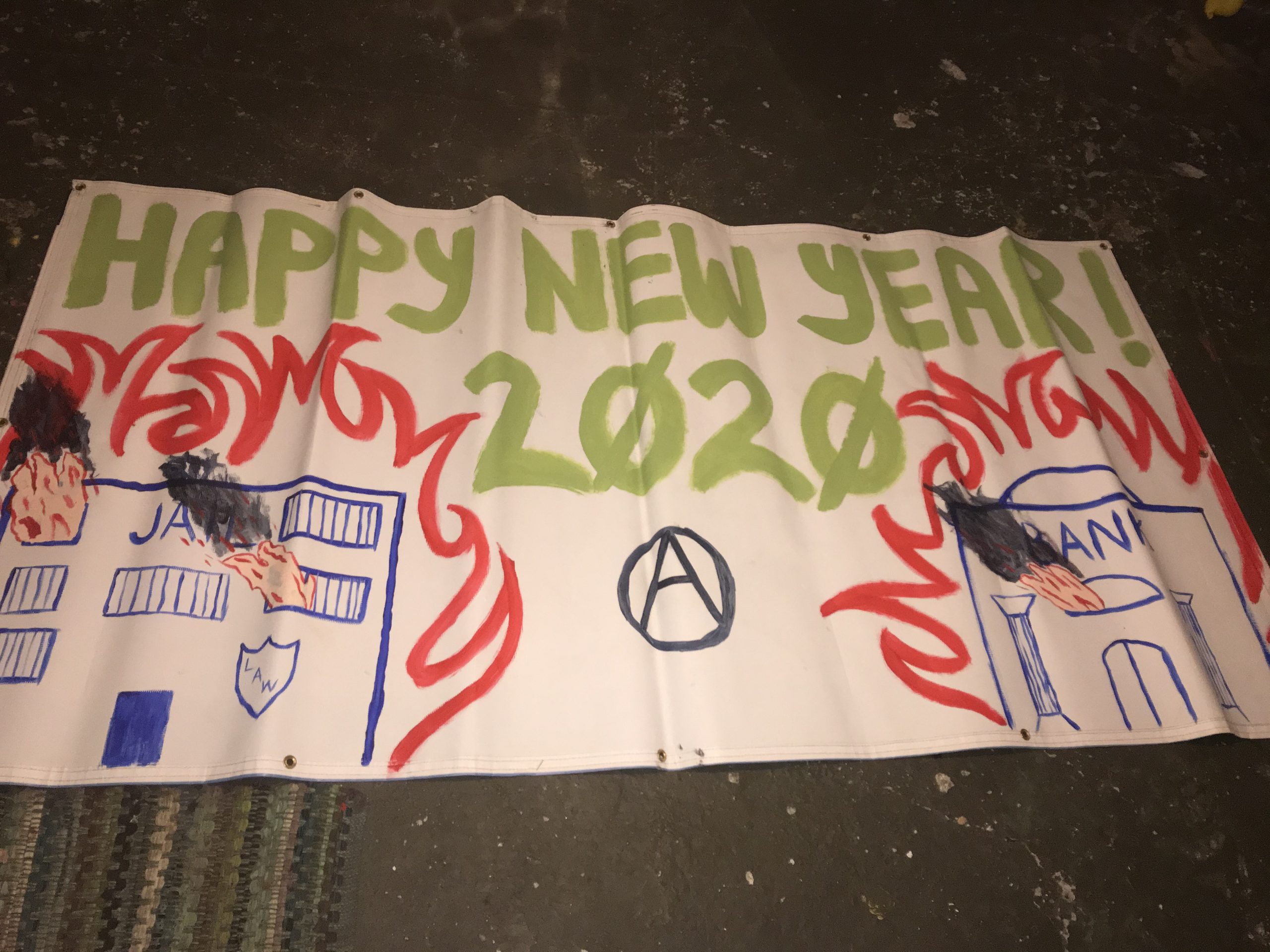
Happy New Year Fuck the System!
On NYE in Philly about 20 anarchist gathered for a march and noise demo at the Federal Detention Center Downtown. At the meet up, after an overview of what to expect, what was planned, and flyers of potential chants were handed out, we set off toward the prison. Marching with a banner, we kept it tight and let people in the streets know what we were doing. We walked on the sidewalk until we realized we didn’t need to. A federal building and indigo bike rental kiosk were tagged by the time we arrived at the prison. Once there, someone tagged ‘Burn Prisons’ on the FDC lolol! We lit off fireworks, smoke bombs, banged flags and pots and sang and shouted solidarity to the prisoners inside, and insults to the cops gathered around us. It was really cool this year to interact with those inside, to see them flashing lights and hear them banging on windows. After 30-45 minutes we took our leave, throwing fliers in our wake. The cops, who had started gathering at the prison, followed us. We had planned for a group fare evasion at the subway as our exit, but with the police breathing down our necks we dispersed in the street instead. Eventually we lost the trails of the cops and made our ways home safely. Some of us even had a funny serendipitous group fare evasion with some strangers, who in seeing us not pay decided they wouldn’t pay either! Yay for the spread of anarchy!
Compared to last year we feel a lot has improved. Whereas last year we were rushed out of our meetup by the appearance of a park cop, this time we had a chance to discuss the action together and share supplies. Security felt tighter also, people’s outfits were secretive and no one was taking photos. Also this year we could really feel a shift in group morale. There was a lot more laughter and joy. We though our chants were funnier and more on point (rather than empty flexes). Maybe most importantly we were able to see and be seen by the people locked up, we saw lights and silhouttes in the windows and could hear them clearing lulls in the noise.
The things we wish went different were: our speaker wasn’t loud enough to play music, our dispersal was sloppy (we feel like it is always hard to predict dispersals/exits but could be worthwhile have multiple plans/multiple backup plans and discuss them in advance), and we could have took the streets a little harder. Overall though, we thought it went well.
We hope this report back is helpful in forming even better strategies in the future. It’s cool to reflect on our strengths and weaknesses and make adjustments over the years.
Shout out to the anarchists who were busy wrecking the nazi supporting bar mill creek tavern on nye!
RIP Kitty
Happy 2020 lets fuck shit uP!!
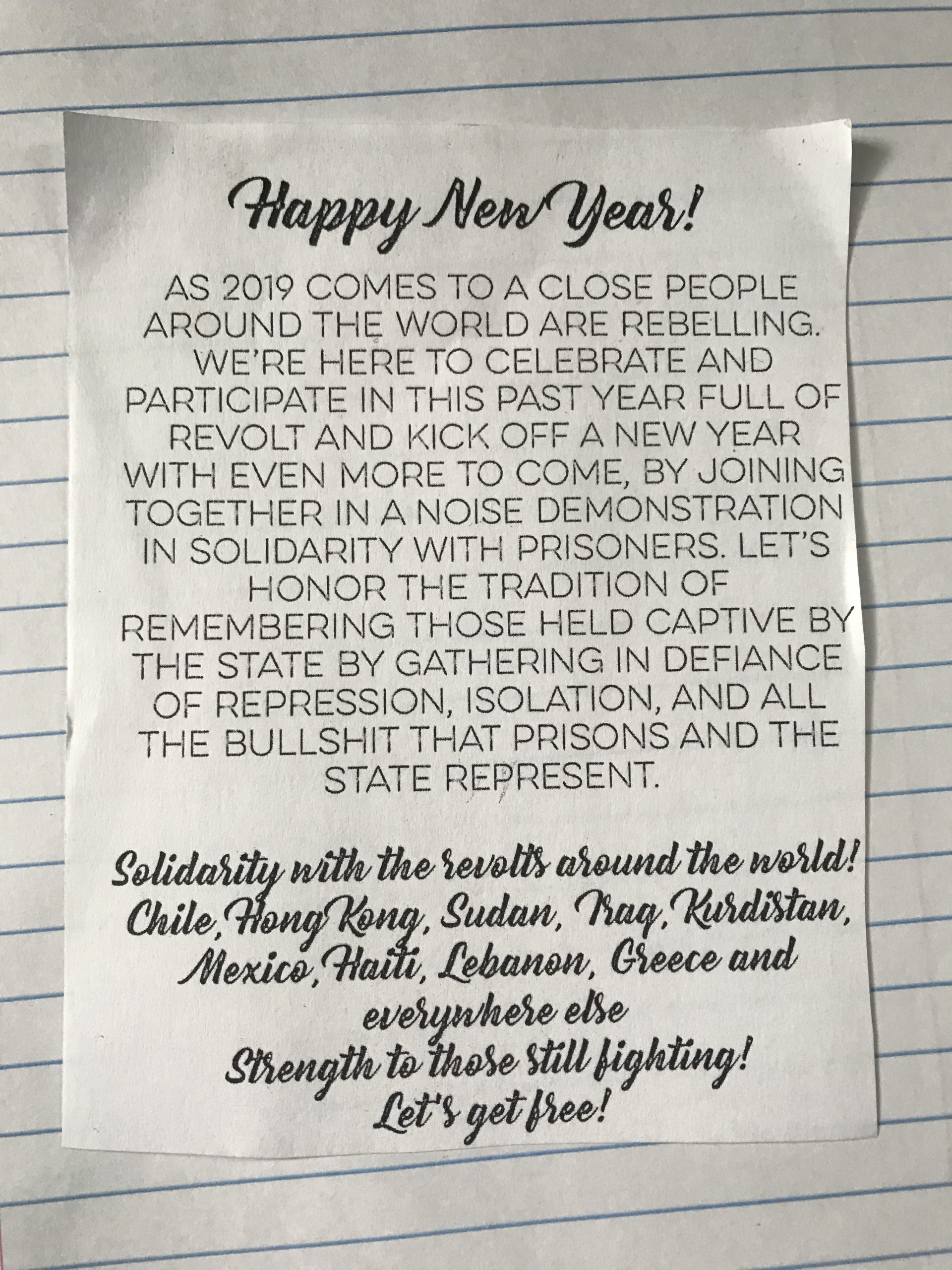




Philadelphia, PA: Anti-ICE Protesters Disrupt Devereux Gala Against Detention of Migrant Children
from It’s Going Down
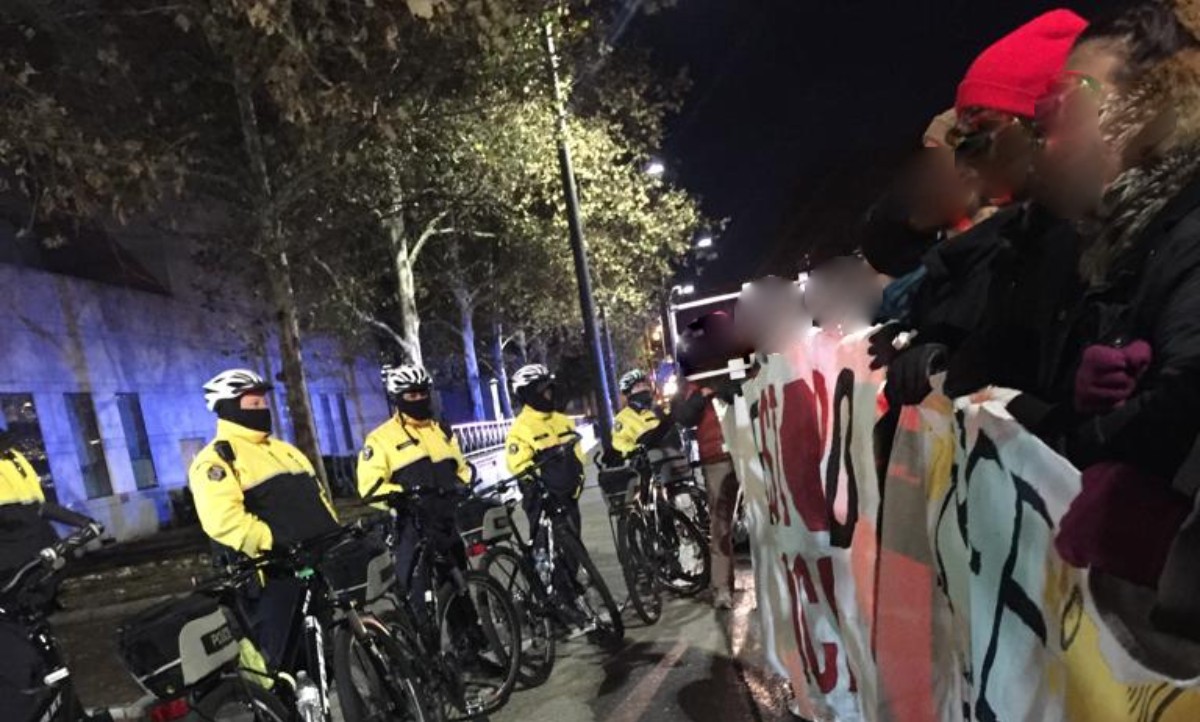
Report from recent action in Philadelphia against Devereux which has accepted a contract to open several migrant youth detention facilities.
On Saturday night, over 100 Jews, immigrants, and allies marched in the streets as others from the group infiltrated the annual fundraising gala of Devereux Advanced Behavioral Health. The demonstration was part of a larger campaign highlighting the $14 million contract Devereux accepted from the federal government to open several migrant youth detention centers. This action is the latest escalation from the national Jewish movement Never Again working in collaboration with local immigrant justice organization Juntos to demand that Devereux stop detaining migrant children.
On the streets outside of the event, protesters marched from 8th and Cherry to the National Constitution Center where the gala was held. Protestors chanted slogans like “It’s Not a Shelter, It’s a Jail” and blocked the Constitution Center parking garage where Devereux was offering free parking to its guests.
On October 17th, several dozen protestors from this campaign blocked the main exit to Devereux National Headquarters while protesting the nonprofit’s plans to hold migrant children in a detention center in Devon, PA. Devereux plans to use its $14 million contract from the Office of Refugee Resettlement to operate multiple youth detention centers nationwide, including one in Devon, PA, where they plan to house 42 migrant children who crossed the border without an adult.
Although Devereux calls them “shelters,” their facilities for migrant children are in fact detention centers since the children held there will be forbidden from leaving. “These young people need to be immediately reunited with their families or sponsors, not detained,” said Juntos Executive Director Erika Almirón, adding that agencies like Devereux “aren’t trying to help these children, they’re trying to make money.”
Devereux claims to be “apolitical” and “neutral” on immigration policy, but its participation in the terrifying status quo is cowardly. The number of kids in cages is higher than it’s ever been, and only growing under this administration. In 2019 alone, 70,000 migrant children were detained, including infants and toddlers — more than ever before in the US and more than any other country in the world.
The detention center in Devon recently had its zoning permit revoked and organizers demand that Devereux accept this decision. They further demand an end to corporations profiting off of immigrant detention, the complete defunding of ICE and CBP as overall agencies, and permanent protection for all undocumented immigrants, refugees, and asylum seekers.
Running Down The Walls 2019 Reportback
from Philly ABC

Philly ABC is happy to report the success of our second annual Running Down The Walls in support of political prisoners, held on September 7th, roughly 2 years from the date that our group formed. We again chose a late summer date for the event, but we hope to align our 2020 RDTW with other ABC chapters. We also joined the ABCF earlier this year to more closely work with our long-term comrades in the LA and former Philly ABC chapters.
We gathered at 10 am in FDR park for a yoga warm-up led by Sheena Sood. It was a beautiful morning, warm and sunny with a nice breeze coming off the lake. Two laps around the park loop is conveniently almost exactly 5K. Like last year, we split into 3 groups: walkers, joggers and runners. Walkers left the starting line around 11 am, followed by the joggers at 11:10 and the runners at 11:20. Afterward, we gathered for a group photo, speeches by Mike Africa Jr. (son of Debbie and Mike Africa who were also participating in the event), Janet and Janine Africa, and refreshments provided by Food Not Bombs Solidarity.
[video]
[video]
Together we raised a total of $1940 to split between the ABCF Warchest, and the Never Give Up! project started by Mike Africa Jr. to provide long-term support for released members of the MOVE 9. We chose royal blue as the color for this year’s shirt to support and raise awareness for Chuck Africa’s fight against colon cancer from within prison. Chuck Africa is up for parole later this year, and along with Delbert Africa is one of the remaining members of the MOVE 9 not yet paroled. Another long-term comrade behind bars in PA, Russell Maroon Shoatz, is also battling colo-rectal cancer so we ran in royal blue in solidarity with him as well. Maroon’s support team is collecting funds to help secure him holistic health options.
At the time of last year’s RDTW, in commemoration of 40 years since the arrest of the MOVE 9, only Debbie had been paroled. This year we were grateful for not only the release of Mike and his reunification with Debbie and family, but the release of Janet, Janine and Eddie as well, all of whom participated for the first time outside of prison walls! We look forward to more successes in the next year!
Until all are free!
Philly ABC
Jovi Val Shouted Down by Antifascists, Tagged with Gritty Sticker, Escorted Out by Cops in Philadelphia
from It’s Going Down
[This post only contains information relevant to Philadelphia and the surrounding area, to read the entire article follow the above link.]
Unregistered gun-haver Jovi Val was detained by law enforcement Saturday in Philadelphia, when he showed up to troll the March to End Rape Culture (formerly known as the SlutWalk). Val was escorted away by police for blocking the entrance to a Marriott hotel. He refused initial orders to leave because he was surrounded by antifascist protesters, and was eventually led away by law enforcement.
Val wore a Proud Boys hat and carried a bizarre sign reading “Trump is a Jew – Everything.”
Prior to Val’s detainment, an antifascist managed to tag his sign with a sticker of antifa icon Gritty.
In April of this year, Val organized a “Fash Bash” celebration of Hitler’s birthday in the Poconos, along with the neo-Nazi New Jersey European Heritage Association. In mid-September, Jovi Val was a featured speaker at a pro-Trump rally in Dalonega, Georgia, which was organized by neo-Nazis, even though Val claims to no longer be involved in the MAGA movement.
Uprising at George W. Hill Correctional Center, Pennsylvania
from Perilous Chronicle

George W. Hill Correctional Facility, Thornton, Pennsylvania
September 2, 2019
According to the Daily Times, a guard at George W. Hill Correctional Facility reported a “full-blown riot” at the facility on Monday.
“I’ve been there almost 20 years and it was the worst experience I’ve ever seen in my life working at Delaware County prison,” said another guard. “It was horrible. It was unsafe.”
“Two entire blocks refused to lock in,” the guard stated.
In response to prisoners refusing to lock down, guards entered the block in an effort to show willingness to use force.
Prisoners responded by covering their faces with ripped bed sheets and wielding shoes against the guards. When it became clear the prisoners were not going to comply, the guards retreated and a CERT team was called in to respond to the uprising.
The CERT team was armed with pepper ball guns and reportedly shot over 25 prisoners. Prisoners were also hit with batons.
In total the standoff lasted about an hour.
The uprising reportedly started on a day when the air-conditioning units were not functioning properly in the prison.
A statement from a spokesperson for GEO Group, the private company that operates the facility, stated, “Staff responded to a small group of disruptive inmates that were repeatedly non-compliant,” the spokesperson said. “All policies and procedures were implemented to maintain the safety for the staff and inmates until the issue was resolved.”
An interior report of the incident indicated that a call came in at 3 p.m. Monday saying that two pods had refused to lock in. About 20 officers responded and successfully got one of the pods to lock down. The other pod of approximately 44 inmates refused orders to lock down.
The report indicates the last staff member out of the block dispersed MK-9 pepper spray into the area before exiting. Further attempts to communicate with the inmates in the block were unsuccessful.
There were still 26 inmates refusing to comply when the CERT team entered and used pepper balls in an effort to regain control of the pod. Guards ordered prisoners to lie down on the ground but only half complied, according to the report.
“It just turned into an all-out war,” said one guard who accompanied the CERT team, “They were not going down without a fight. It was unbelievably scary … It was like something you see out of TV.”
The remaining 13 inmates were eventually subdued and handcuffed. A search of the pod’s dayroom later uncovered a makeshift knife, according to the report.
One guard said in a statement,“This was just the beginning. Now they’re prepared. They tested us and now they’re going to do it again, because they know we’re short staffed. I’ve been there long enough and I’ve seen enough to know that will happen. A CO is going to die.”
Citations:
“Guard says staff put down ‘full-blown riot’ at Delco prison Monday“, Daily Times, September 4, 2016.
Article published: 9/12/19
17-17-17 by Dwayne “BIM” Staats

On October 17th 2017, 17 prisoners were indicted for allegedly partaking in the uprising that occurred at James T. Vaughn Correction Center in Smyrna Delaware on February 1, 2017. This miscellany of individuals would eventually be given the moniker “Vaughn 17.”
Contrary to our charge of “conspiracy,” prior to this case many of us had never interacted with one another before. As far as myself I only knew 3 of my co-defendants on a personal level. I believe this unfamiliarity exacerbated the tensions that arise while one is engaged in a struggle for life, freedom or truth. Ultimately our triumph hinged upon surmounting psychological barriers that were buttressed by our diverse array of ideologies, idiosyncrasies, experiences, maturity levels and ways of life. Out of all that, there still remained a sad but proven reality that weighed heavily on our minds. There’s 17 co-defendants — the odds are in favor of at least 4-6 opting to cooperate with authorities to secure some type of leniency for their cowardice. With that being the foremost concern, me and Jarreau “Ruk” Ayers approached individuals and recommended that they first consult with us, if they found themselves pondering thoughts of compromising. Being though the vast majority wasn’t privy to or knowledgeable of any specifics concerning the takeover, we would of provided them with details pertaining to our actions, so they wouldn’t concoct fabrications about anyone else. Figuratively speaking we’d accept being stabbed in the chest to present others from getting stabbed in the back. Only one person gave the proposal any consideration. More than anything he was frightened of the maliciousness of the deputy attorney generals, and felt vulnerable against the power they wield. Imagine going to sleep at night with 4 years remaining on your sentence, then morning comes and your greeted by 3 counts of murder, 3 counts of assault, 4 counts of kidnapping, 1 count of riot, 1 count of conspiracy. Internally a lot of my co-defendants were grappling with this abuse of discretion, but they never expressed any desire to seek a pseudo refuge in anticipation of the metaphorical slaughter that some thought was inevitable.
During these preliminary stages it definitely appeared as though the prosecutors had everything rigged to ensure our guilt. The department of corruption aided their accomplice. By keeping us sequestered in living quarters conducive to the deterioration of one’s mind. Some of our adversaries disguised themselves as court appointed lawyers. The system “tried” to box us in on every level. For the first 8 or 9 months the only discovery (evidence) that “some” of us received was co-defendant statements, DNA analyses, and other reports that were deemed paltry. Any material critical to our defense specifically, information alluding to why we were charged was held under a protective seal by a judge’s order. The cumulative effect of these hinderances (tactics) provoked one of my codefendants to contemplate “throwing in the towel,” somehow he rationalized that pleading guilty to something he had no involvement with was a viable solution towards evading the barrage of mental intrusions. Their schematic design became so overwhelming that it nearly infringed upon his sanity. To a degree, all of us were on the verge of psychological exhaustion. Instead of mentally collapsing, it caused us to start making conscious efforts to morally support each other. This was around the time my motion to go pro se (represent myself) was granted. I filed a subsequent motion stating that I be issued a laptop and be given all the discovery discs that the lawyers were entitled to. My request was granted with the stipulation that I adhere to the rules and regulations of the protective order. Which basically meant that I share nothing with my co-defendants. “Yeah Aight!” Once I started receiving the material “we” began analyzing it. Simply saying that we immersed ourselves within this case would be an understatement. I never witnessed a group of individuals move with such a synchronized mind. “Due diligence” is why truly empowered our collective. After sifting through the discovery, which amounted to 7 boxes of documents and about 45 discs. There was no physical evidence, no surveillance footage, or forensic evidence. It all came down to our 17 against 41 lying snakes.
The results: Me and Ruk was found guilty, for basically admitting to our levels of involvement. Deric Forney, Kevin Berry, Abednego Baynes, and Roman Shankaras were acquitted. John Bramble and Obadiah Miller had a hung jury on a few of the charges, but a retrial would not be pursued. Cory Smith, Luis Sierra (Abdul Haqq), Janiis Mathis, Robert Hernandez, Jonatan Rodriguez, Alejandro Rodriguez, Pedro Chairez and Lawrence Michaels all got their cases dismissed. R.I.P. to Kelly Gibbs who took a plea during jury deliberations of the first trial. He committed suicide the night the verdicts returned.
This narration of events was shared to provide a fundamental basis to delineate another nuance of “Vaughn 17.” Like I mentioned, we were essentially strangers comprised of different races, affiliations, motivations etc. Some of my co-defendants had real beefs on the streets. We are a microcosm of the prison population, which reflects society as a whole. I just want to put emphasis on how our discrepancies became inconsequential after the true enemy was identified. If the 17 of us along with our comrades and supporters could unify to deliver a blow that caused the political landscape in Delaware to implode imagine what 1,700 or 17,000 strong can accomplish….
The power is the people.
-BIM
NJ Boneheads Tried to Cause Trouble at Philly I.C.E. Protests
from Idavox
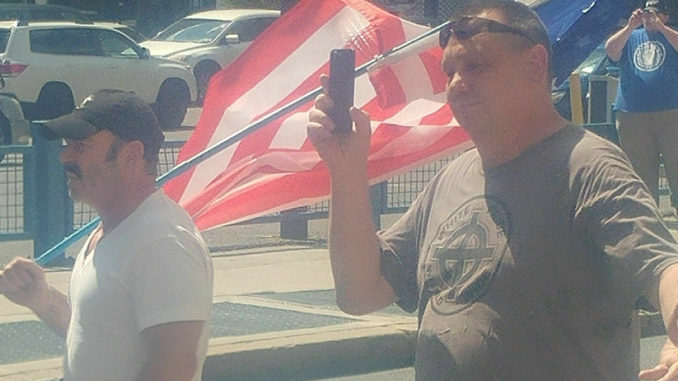
Ron Sheehy and Dan D’Ambly led a crew of four people to harass members of the Jewish community and their supporters protesting Trump’s concentration camps. Gee, whatever got their dander up?
PHILADELPHIA, PA – Neo-Nazis, two who were readily identified as participants in the 2017 “Unite the Right” Rally in Charlottesville, were seen at an anti-ICE protest at Independence Hall today.
Jewish-American organizations across the country organized this week to be a national “Never Again Week of Action,” and are holding similar marches across the U.S., linking the current immigration enforcement tactics employed by the U.S. Immigration and Customs Enforcement (ICE) to the Holocaust. “As Jews, we’ve been taught to never let anything like the Holocaust happen again,” the Facebook event page reads. “Now, with children detained in unacceptable conditions, ICE raids targeting our communities, and people dying at the border while seeking safety in the US, we are seeing the signs of a mass atrocity. We refuse to wait and see what happens next.”
During the march, four White men identified as neo-Nazis were heckling the passing protesters with anti-Semitic language. Of the four, two were identified because of their notoriety. Dan D’Ambly of the New Jersey European Heritage Association (NJEHA), raised the Betsy Ross American flag while shouting at passers-by, while Ron Sheehy, once of the Advanced White Society joined him while videotaping those he was heckling on his cell phone. According to a since deleted post from his “Tremley” account on Stormfront, the other two were members of NJEHA.
Sheehy also said the four of them later attempted to lay a wreath emblazoned with NJEHA decals on the grave of Ben Franklin but was met with opposition. “We all paid $3 each to get into the Cemetery, and we asked if we can lay a Reef (sic) on Ben Franklin’s Grave Site so we can take a Picture,” he wrote. “(T)hey said ok, but once we did, 2 queer guys who worked there flipped out and tried taking the Reef (sic) away from us. A lot yelling back and forth with them calling us White Supremacist and stuff, so we left after that.” Sheehy also went to an anti-I.C.E. protest earlier this week at the offices of Rep. Tom Malinowski where he heckled the protesters while videotaping them. It is not known at this time if anyone joined him there.
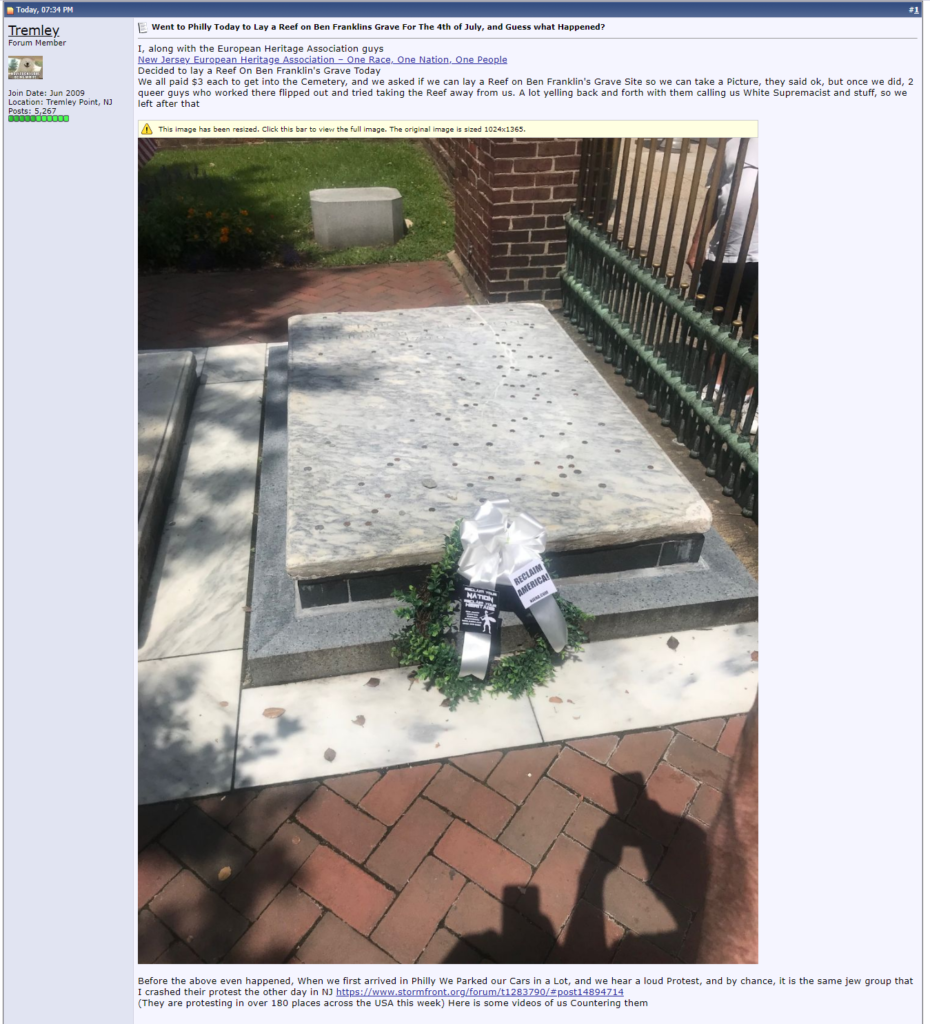
D’Ambly is best known for attempting to hold a rally in Princeton, NJ but failed to show once the residents learned of his plans. The NJEHA seldom, if ever, hold public rallies, opting instead to post flyers on telephone poles in various cities around the state. Sheehy has been seen often at anti-immigration events over the past decade in the New York City area, and just like D’Ambly was photographed at the rally in Charlottesville which cost this life of 32-year-old Heather Heyer, who was killed when White Supremacist James Fields plowed his car into a crowd of protester. D’Ambly was also identified as one of the participants of the “Unite the Right 2” rally the following year in Washington, DC, with his NJEHA organization.
Not done with the #NJEHA just yet. I was going through my Charlottesville 2017 video files and found Dan D’Ambly walking with a crowd of folks. pic.twitter.com/ET1HZ68dSG
— Daryle Lamont Jenkins (@DLamontJenkins) January 27, 2019
Dozens of protesters were arrested during the Fourth of July Parade while marching through demanding those being held in what has been referred to as concentration camps be removed from such establishments, one of them being in Berks County, PA.
June 11 Rundown
Submission
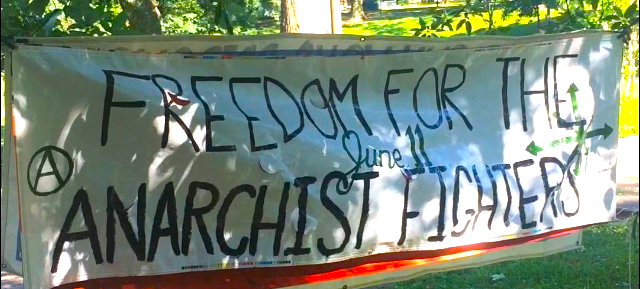
For June 11th anarchist solidarity in Philly took a few different forms. In the lead up to the 11th stickers and posters were put up. Graffiti for anarchist prisoners was written on the Grays Ferry Bridge.
On June 11th a BBQ fundraiser was held. Vegan food and copies of Fireant were given away and money was collected for anarchist prisoners and local anti-repression efforts.
Anarchist prisoners to the street 🙂
Analysis of Action Following the Police Shooting of Kaleb Belay in West Philly
from It’s Going Down
A collection of texts from Anathema, an anarchist publication out of Philadelphia, about anarchist action and analysis following the police shooting of Kaleb Belay in a rapidly gentrifying area of the city.
It’s well known that West Philly is rapidly gentrifying. Developers and more moneyed renters and buyers continue to successfully take more space from poor and working-class Black people. In this process, one of the few negative consequences these newcomers might experience is getting robbed in the neighborhood. In January, the number of robberies in the heart of gentrifying West Philly shot up, in the area between 41st and 49th streets (from east to west) and between Ludlow and Cedar avenues (from north to south). At least eight robberies were reported during that month, according to a University City District (UCD) report. Four homes on Hazel and Larchwood avenues between 49th and 51st streets were also burglarized during this time.
In response, a few of the more unapologetic gentrifiers not only reported the incidents to the police, but also attended a “community meeting” hosted by the police. Following the meeting, the Philly police announced that they would have an increased police presence in the area, including foot patrols specifically in the area between 48th-52nd streets. Sure enough, residents have noticed a lot more cop cars as well as cops on foot in the area since.
On Wednesday, March 6, this increased cop presence and paranoia culminated in the cops shooting a young Black man who live near 49th and Hazel — exactly where gentrifiers had been complaining about burglaries and robberies taking place. Claiming that they had been called to the scene in response to a “stabbing incident” (no stabbing victim was found at the scene) and that he was holding a knife outside a house on the street, the cops shot 25 year old graduate student Kaleb Belay six times (three in the chest). As of this writing he is stable condition at Penn Presbyterian Hospital.
It’s never worth it to call the police over some lost property — and we personally won’t call them to deal with any of our problems. The high 40 and low 50 streets are undergoing intense gentrification. Know that the police’s role is to attract more gentrifiers and push people originally from the neighborhood out. That’s what happened when University of Pennsylvania cleared out an entire neighborhood (what was once called the Black Bottom) of West Philly in order to move the school there decades ago — that’s why UCD security roam the neighborhood.
The police are just looking for an excuse to roll in and further the dispossession and extermination of Black people from the neighborhood.
Resistance Following the Shooting of Kaleb Belay
The night after the police shooting, a group of 20-30 people marched down Baltimore Ave with a banner reading “Fuck the Police.” At least two new buildings on the ave between 50th and 48th streets, all with gentrifying new architecture, had windows broken, and one had “Fuck Cops” written on it. The Mariposa Co-Op, which has been a beacon of gentrification in the neighborhood for a long time (known for calling the police on panhandlers), had red paint thrown at one of its surveillance cameras. Anti-police tags and stickers were put up. After the police arrived, things calmed and the march went to the hospital where Kaleb is recovering before dispersing. Throughout the march many passersby and drivers shouted “Yeah, fuck the police!” and other words of encouragement. There were no arrests.
On March 8th, opportunists Refuse Fascism/Revolutionary Communist Party held a candle-lit vigil for Kaleb near the site of the shooting. This event was poorly attended and seen by many as an attempt to use the grief and anger around the shooting to recruit for their organization.
On March 10th, the Philadelphia Ethiopian Community held a debrief and discussion at the Ethiopian Community Center in West Philly. Kaleb’s lawyer and his boss/family friend gave updates on his situation. Next steps to assist Kaleb and his family were planned. Over the weekends of March 16-17th and 23-24th there were fundraiser events for Kaleb at the Ethiopian Community Center.
A march demanding justice for Kaleb went to the district attorney’s office on April 6th. Simon Haileab, Kaleb’s attorney, reports that Kaleb is recovering slowly; he is out of the intensive care unit but remains at Penn Presbyterian Medical Center. Police are charging him with aggravated assault, simple assault, and possessing an instrument of crime. Anyone interested in donating money to Kaleb can do so by visiting his gofundme here or dropping off money at Bookers Restaurant at Baltimore Ave and 50th St.
An Analysis Of the Anti-Police March Following the Shooting of Kaleb Belay
When some discontents spray-painted and smashed windows after the police shot an immigrant graduate student in Cedar Park, many were quick to condemn the attacks. These criticisms did not target the anti-police and anti-gentrification sentiment behind the attacks, but rather their choice of targets. The thing about anger and revolt is that it strikes out at what is perceived as oppressive.
No uprising has ever surgically delivered anger to the doorstep of only the most oppressive and powerful, while excluding the lesser contributors of a stifling society. Not everyone is going to track down the head honcho of this or that realty company when they see an example of gentrification around the corner.
In relative terms, what happened to the businesses on Baltimore Ave is calm; police violence has sparked much more devastating responses in other contexts – like the burning of entire neighborhoods.
It also bears mentioning that at the time of this writing, despite many critics suggesting better targets for vandalism (the police, University of Pennsylvania, money lenders, banks, etc), none of these targets seem to have been vandalized. These critics seem content to suggest how others express their anger and direct their rebellion without doing so themselves. If these people are waiting for the ideal targeting of the proper institutions and yet they do not plan on going after them themselves, they are simply waiting. When people start to condemn all but the most pure and correct actions, they climb the stairs of an ivory tower.
Will arrogance about how others struggle move someone closer to freedom? It seems more likely to lead to further separation from those who are struggling and making concrete their rebellion, to create a roadblock for feelings of solidarity. Throwing paint at the expensive Mariposa Co-Op grocery store and breaking the glass door of a fancy-looking new apartment building along Baltimore Ave, some of the actions during the demo that were later criticized by others, targeted small businesses whose gentrifying impact is felt in this particular neighborhood where police shooting took place.
It is gentrification that led to the increased police presence in this neighborhood, which inevitably led to a black man getting shot. In addition to wanting to push back against gentrification in this area, those who criticize colonialism, or ecological destruction, those who hold nihilist perspectives, and even the less discriminating among the anti-capitalists may see the destructive actions on Baltimore Ave as a step in the right direction. We don’t all imagine liberation in the same way, but it should be understood that a dramatic transformation of society is necessary, so when we see that taking place on a small scale as destruction we can understand it to be part of that liberatory transformation even if you would go about it that way yourself.
“There are many who await the hour of liberation impatiently, but how many work to bring it closer?”
Unicorn Riot Coverage of Candace Owen Protest
from Twitter
Far-right campus group Turning Point USA’s director Candace Owens just showed up at UPenn campus in Philadelphia. She ignored our questions about whether TPUSA plans to address ongoing neo-Nazi infiltration and recruitment among their membership.
[Video Here]
[Video Here]
[Video Here]
Spring issue of Friendly Fire
from Friendly Fire
Militant discipleship, revolutionary eschatology, tarot, info on our upcoming retreat what’s there not to love about the newest issue of Friendly Fire? Check it out here
Also, you can still apply to the retreat in Minnesota (June 17-20)! You can do that here. Applications are due 4/15.
And if you have any spare cash to help comrades make it out to the retreat, you can donate here on our Chuffed.
Aries Blessings!
On The Recent Events In West Philly
Submission
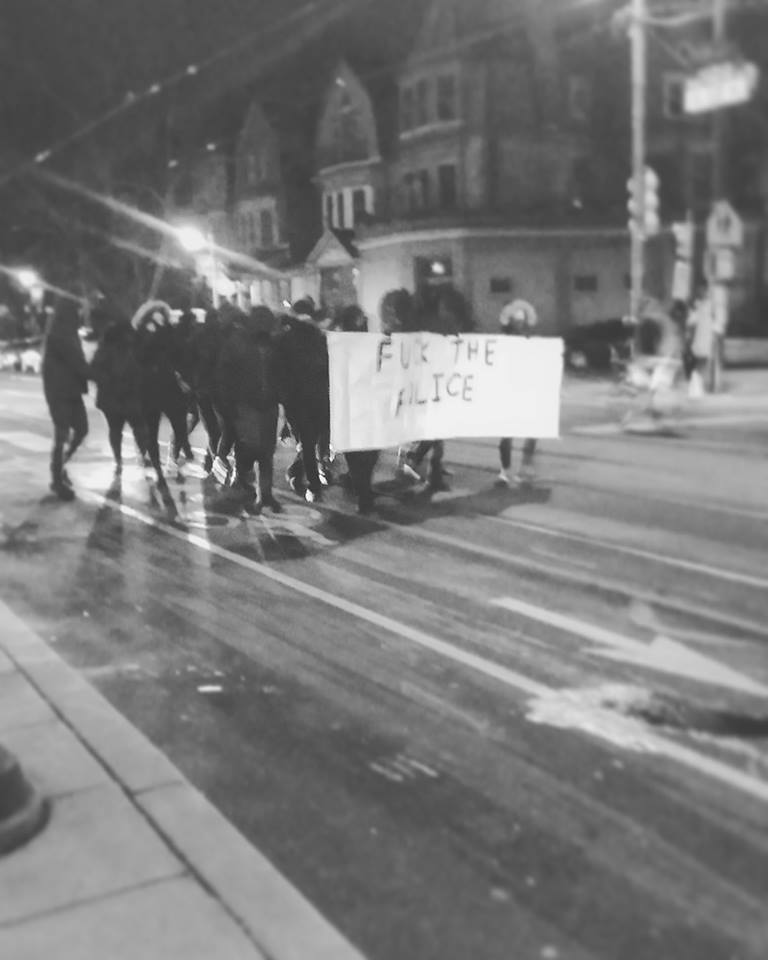
It’s well known that West Philly is rapidly gentrifying. Developers and more moneyed renters and buyers continue to successfully take more space from poor and working-class Black people. In this process, one of the few negative consequences these newcomers might experience is getting robbed in the neighborhood. In January, the number of robberies in the heart of gentrifying West Philly shot up, in the area between 41st and 49th streets (from east to west) and between Ludlow and Cedar avenues (from north to south). At least eight robberies were reported during that month, according to a University City District (UCD) report. Four homes on Hazel and Larchwood avenues between 49th and 51st streets were also burglarized during this time.
In response, a few of the more unapologetic gentrifiers not only reported the incidents to the police, but also attended a “community meeting” hosted by the police. Following the meeting, the Philly police announced that they would have an increased police presence in the area, including foot patrols specifically in the area between 48th-52nd streets. Sure enough, residents have noticed a lot more cop cars as well as cops on foot in the area since.
On Wednesday, March 6, this increased cop presence and paranoia culminated in the cops shooting a young Black man who live near 49th and Hazel — exactly where gentrifiers had been complaining about burglaries and robberies taking place. Claiming that they had been called to the scene in response to a “stabbing incident” (no stabbing victim was found at the scene) and that he was holding a knife outside a house on the street, the cops shot 25 year old graduate student Kaleb Belay six times (three in the chest). As of this writing he is stable condition at Penn Presbyterian Hospital.
It’s never worth it to call the police over some lost property — and we personally won’t call them to deal with any of our problems. The high 40 and low 50 streets are undergoing intense gentrification. Know that the police’s role is to attract more gentrifiers and push people originally from the neighborhood out. That’s what happened when University of Pennsylvania cleared out an entire neighborhood (what was once called the Black Bottom) of West Philly in order to move the school there decades ago — that’s why UCD security roam the neighborhood.
The police are just looking for an excuse to roll in and further the dispossession and extermination of Black people from the neighborhood. Don’t give them one!
The night after the police shooting, a group of 20-30 people marched down Baltimore Ave with a banner reading “Fuck the Police.” At least two new buildings on the ave between 50th and 48th streets, all with gentrifying new architecture, had windows broken, and one had “Fuck Cops” written on it. The Mariposa Co-Op, which has been a beacon of gentrification in the neighborhood for a long time (known for calling the police on panhandlers), had red paint thrown at one of its surveillance cameras. Anti-police tags and stickers were put up. After the police arrived, things calmed and the march went to the hospital where Kaleb is recovering before dispersing. Throughout the march many passersby and drivers shouted “Yeah, fuck the police!” and other words of encouragement. There were no arrests.

As is usual, the police and media are trying to confuse and bury the story. Initially police reported responding to a call of a man with a weapon, then they said it was a stabbing, although no stabbing victim was found. News media have not been prioritizing the story, instead continuing to publish other stories that justify the further policing of West Philly.
The Eritrean and Ethiopian networks in Philadelphia have come together to support Kaleb. Fundraising efforts have begun to help with costs associated with surviving being shot by the police. A vigil has been organized, and other support meetings have already taken place.
The police and gentrification work together to displace, imprison, and eliminate black and brown people. Each reinforces the other. Gentrifiers encourage the police to do their job, and the police create a welcoming environment for gentrifiers. It’s not surprising that gentrifiers are inviting the police into the neighborhood through the rhetoric of crime and safety (being racist is passe). Despite what either group says, their goals align. It should come as no surprise that Kaleb was shot by the police after neighbors reached out to the police to be more present in the area.
It makes sense to us that people are attacking construction and new buildings in the wake of a gentrification-enabled shooting. Fuck the police! Fuck gentrification!

Notes and Critiques from the Philly Anarchist uhh…Network? Meeting? Caucus? Jawn?
Submission
Vaughn 17 Trial 2, Week 4: The Defense’s Case
The fourth week of this incredibly long and punitive trial saw defendants Abednego Baynes, Kevin Berry, John Bramble, and Obadiah Miller finally able to speak to the lies the state’s used to construct a case against them. Two defendants from the first trial — Jarreau Ayers and Dwayne Staats — also testified this week, revealing new information about the parts they played regarding the takeover. Other inmate defense witnesses completely discredited the testimony of several of the state’s witnesses, leaving the state with even less of a case against any of the remaining defendants.
Monday, February 4th, saw the tail end of the prosecution’s case. After two weeks of unreliable testimony from unlikeable inmate witnesses, on Friday the state had finally managed to produce a somewhat competent witness, Michael “Latino” Rodriguez. Rodriguez testified that he saw Bramble assault Officer Wilkinson and that he saw Miller stab Sergeant Floyd. Monday’s cross-examination showed that Rodriguez’s testimony contradicted that of other inmates, that he’d gotten information about what’d happened from other people, and that his motivation for cooperating was to get out of jail rather than having been moved by his “conscience.” But he seemed to have made a better impression on the jury than previous witnesses. After lead investigator David Weaver testified about the investigation again, the prosecution rested on Monday.
“I shouldn’t be here.” – Kevin Berry
Kevin Berry’s defense began by calling a few fellow prisoners who were with him during the takeover and attested to his lack of involvement. One prisoner, Joseph Galloway, discredited state witness Henry Anderson’s testimony, saying he was asleep during the assaults he’d said he saw: “Unless he’s superman, he didn’t see nothing cuz he never left the room.” When questioned, he also said that no one had been down near the hot pot watching the assaults, which wipes out another state witness’ testimony. Berry then testified, noting the “bullshit stories” of the prosecution’s witnesses and explaining to the jury that he should never have been charged.
“Peaceful protests don’t work. I’m past that.” – Dwayne Staats
Obadiah Miller’s defense counsel brought up Jarreau Ayers, who admitted he’d lied during the previous trial and that he had in fact collaborated with his co-defendant Dwayne Staats to plan the takeover. Ayers explained he’d made the decision to risk perjury and attest to this now because he’d come to realize that the uprising was a “righteous cause” and that he needed to accept responsibility for it. He said he couldn’t bear to see men who had nothing to do with the takeover being convicted for things he’d decided to do, even though it meant that he now stands no chance of ever leaving prison. Ayers told the courtroom, “I’m sacrificing everything to be here today.”
Staats also expanded on his role in the takeover. During his and Ayers’ trial in the fall, Staats had explained (not under oath, according to him) that he had sought to plan the takeover along with other “lifers” — people who had nothing to lose — and had recruited six other prisoners to take part. On Wednesday of this past week, Staats told the court that he’d also been the first to punch Sergeant Floyd, a signal that attacks on all the officers were to begin. This new admission made the prosecution furious. Staats shrugged this off, explaining that his defense had been based on what the investigators said about him, and that they hadn’t been able to find a witness who said they’d seen him hit anyone.
Ayers and Staats both convincingly explained why they had not recruited the particular defendants on trial to take part in the prison takeover. Of Bramble, Ayers said “Can I be honest? He and his friends just get high all the time.” When asked if any white guys had been asked to participate in the uprising, Ayers laughed and said, “No.”
Staats explained that he’d seen firsthand that Kevin Berry didn’t have the potential to be part of the takeover when an officer had put hands on Berry previously and he did nothing in response. Neither of them knew Baynes, who kept to himself. Miller was known as a tier man, who, as Staats explained, were handpicked and trusted by the police, meaning they were not trusted by other inmates. Miller also testified to this in his own defense, explaining to the jury that many of the inmates who’d lied about his involvement in the uprising had problems with him because he’d been picked for the job despite others having seniority over him.
Baynes testified on Wednesday that he’d spent the morning of the takeover watching Rachel Ray, which he watched every day, and that he’d left before it was over. When questioned about masked inmates he’d seen at a distance during the uprising, he replied, “If you want me to guess, I can play a guessing game like your witnesses did.”
After much censorship and condescension from Judge Carpenter, Baynes’ defense attorney Cleon Cauley was finally allowed to bring up prison expert and correctional operations consultant James Aiken. Aiken testified that inmates should be housed separately after a “critical incident” in order to minimize “contamination” of the investigation. In this case, they were housed together; some people who are now state witnesses were even in the same cells. The judge did not allow him to testify about several significant matters.
John Bramble’s defense presented one prisoner who’d been cellmates with Melvin Williams, who had testified previously that Bramble had come to his cell saying he’d attacked Floyd. Williams’ cellmate testified that no one had ever come to his cell that day saying that. Another inmate’s testimony discredited testimony from another state witness, Larry Sartin. The most significant testimony that day, though, came from prisoner Terek Downing, who had taken care of Counselor May in his cell during the uprising and had witnessed the attack on Sergeant Floyd. Downing exonerated Bramble, whom he’d seen also watching the attack. Downing also completely undermined the previous testimony of state witness Carello, who he said stayed in his cell during the attacks he said he’d seen, and described state witness Rodriguez’s claim that he had also been with Ms. May as “completely false.” Like several defense witnesses before him, Downing described the case against the current defendants as “frustrating” and told the court, “Y’all got the wrong people on trial.”
Bramble’s testimony closed out the defense. Bramble spoke out against state witness Michael Carello’s (now-discredited) claim that Bramble had bragged that he’d “gutted Floyd like a whale, and felt like a KKK member while doing it.” Bramble responded: “That doesn’t even make sense. My mom is black and my little sister and brother are half-black. I was ashamed when he said that. That’s offensive.”
Bramble also spoke to the brutality endured by C-building’s inmates right after the takeover, which he described as a “full-on assault.” Lieutenant Vanes, who’d commanded the force that eventually blitzed the building, had testified that they had used force because prisoners were resisting. Bramble testified that no one had resisted.
Four to five days after the takeover, the 18 prisoners who were ultimately indicted were chosen to be moved to a different building. For a week, Bramble testified, they had only the clothes they’d had on, which were still wet, and no shoes. They weren’t allowed to take showers or make phone calls for five days. When transferred to a different prison, they were put on a tier with nothing, their property was confiscated again, they weren’t given property or books for three months, and they had to go on a hunger strike in order to get their allotted recreation time.
The prosecution succeeded in getting some moderate convictions in the first Vaughn 17 trial because two of the defendants, Ayers and Staats, offered up testimony regarding their involvement in the takeover. The third defendant, Deric Forney, whom only a few witnesses claimed to have seen assaulting an officer, maintained his innocence and was acquitted on all charges.
This trial is different. This time, all four defendants are in Deric Forney’s position. A few more state witnesses have “evolved” their stories to include Bramble and Miller’s names, and there is a questionable DNA sample related to Miller, who as a tier man had regular access to where it was found. But Bramble, Miller, Berry and Baynes have all held out under pressure and abuse for the past two years to stay in solidarity with their co-defendants. They have now convincingly attested to their lack of involvement in the takeover and some of the ways in which they were targeted as part of the state’s desperate attempt at retaliation for one of the most important uprisings so far this century.
The prosecution and the defense’s closing arguments will take place on Monday, February 11, starting at 9:00am in Room 8B at the New Castle County Courthouse in Wilmington, Delaware. Jury deliberations are expected to begin on Tuesday morning.

